Indoor plants add color and beauty to our homes. They are soothing to the eyes and make your space serene. Moreover, plants near you uplift your mood, making you feel less stressed and more productive. But do you know plants also reduce toxins in your homes by purifying the air? Some low-maintenance indoor plants can be managed easily and provide clean air as well. That’s the reason more and more people are placing plants indoors.

Low-maintenance Indoor Plants For Clean Air
Plants are a great source of adding an aesthetic appeal to your indoor space. But the NASA Clean Air Study from 1989 is excellent news for plant lovers. This study found that some indoor plants can purify the air by removing toxins and air pollutants.
In this post, we share some of the best low-maintenance plants that are also best in providing clean air by improving indoor air quality.
1. Pothos
Scientific Name: Epipremnum aureum
Pothos are often called Devil’s Ivy. Pothos as indoor plants is most effective in removing toxins and pollutants from the air. These plants are also added to the low-maintenance indoor plants as they can grow well in any indoor environment.

Care!!!
Pothos requires significantly less attention and water once after two weeks. You should allow the plants to dry in between the waterings as they like it. When given extra water, leaves turn yellow or black, killing your plant. That is why you should avoid extra water. Water a little more in a brighter light than in less light.
Remove Toxins: Xylene, benzene, formaldehyde, and trichloroethylene.
2. Spider Plant
Scientific Name: Chlorophytum comosum
The spider plant is the most adaptive and easy-to-maintain indoor plant. The ribbon-like long green leaves enhance the beauty of your indoor space. Due to its low maintenance, every beginner gets this plant to start their plant journey. This plant emits oxygen at night, which aids in air purification. You can breathe more easily while sleeping.

Care!!!
Overwatering can cause the roots to rot in damp soil, so you don’t worry about these plants. They qualify for low-maintenance indoor plants.
Remove Toxins: Formaldehyde, xylene, benzene, toluene, and trichloroethylene.
Related Article: How to Save a Dying Spider Plant?
3. Aloe Vera
Scientific Name: Aloe barbadensis miller
Aloe Vera has a liquid that is rich in vitamins, enzymes, amino acids, and other substances. With properties of wound-healing, antimicrobial, and anti-inflammatory qualities. It could be grown indoors and is very useful in cleaning the air. It is among the list of low-maintenance indoor plants that can also clean the air.

Care!!!
They thrive in indirect sunlight. Bright direct sunlight can cause discoloration in the leaves of aloe vera. Watering the aloe once per week is enough to grow it healthier.
Remove Toxins: Formaldehyde and benzene
4. Peace Lily
Scientific Name: Spathiphyllum
These plants are comparatively small in size, but they are easy-to-grow plants. Peace Lilies, with their glossy green leaves, make a perfect addition to your indoors. It is a perfect plant for low-light areas and purifies the air for you. They are among the top very low-maintenance indoor plants for clean air. Moreover, these lilies also add pollen and floral scents to the air, which create a fragrance.

Care!!!
Peace Lily is a very adaptable plant and does not need any extra care. Keep them moist and water weekly. Since they like a warm environment, keep them in indirect bright sunlight. Fertilize once in a while in spring to promote the growth of the beautiful white flowers.
Remove Toxins: Benzene, carbon monoxide, formaldehyde, trichloroethylene, xylene
5. Snake Plant
Scientific Name: Dracaena trifasciata
This plant is also well known as Mother-in-law’s tongue. Snake plants are trendy because they’re low-maintenance indoor plants for clean air and easy to care for. These plants have a versatility that’s hard to surpass, especially regarding light requirements. Moreover, the snake plant is an excellent indoor plant as it releases oxygen at night, purifying the air. NASA’s report recommends one plant every 100 square feet. Or with no airflow in the room, 6-8 plants are enough for one person to survive.

Care!!!
These hardy plants flourish in every light condition, from low to high. They don’t require a lot of light and can handle less water. These plants thrive in dry conditions, so avoid overwatering.
Remove Toxins: Benzene, carbon monoxide, formaldehyde, trichloroethylene, xylene
6. Rubber Plant
Scientific Name: Ficus elastica
Rubber plant, with their large oval-shaped glossy leaves, is an excellent choice for an indoor plant. It is a low-maintenance easy-to-care houseplant and also cleans the air, according to a study by NASA. The leaves can absorb harmful toxins from the air. Moreover, it also purifies the air by absorbing carbon dioxide into breathable oxygen.

Care!!!
Rubber plants require comparatively less watering when compared to other indoor plants. Watering your rubber plant every one to two weeks is a good idea, but you should let the potting soil be your guide: It needs to be fully dry between waterings.
Remove Toxins: xylene, benzene, formaldehyde, and trichloroethylene.
WARNING!!! Rubber plant leaves are not safe for humans and pets. They can be toxic if swallowed.
7. Areca Palm
Scientific Name: Dypsis lutescens
If you have a bigger space, you can easily make it look beautiful and peaceful by placing areca palms. They are perfect for large spaces like living rooms. Another good feature is that it is totally pet safe, so you don’t need to worry if you have cats and dogs. Areca palm is also an air purifier as it absorbs harmful toxins and chemicals from the air and provides clean air.
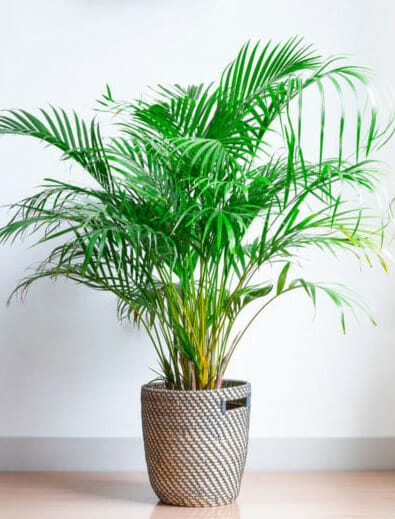
Care!!!
Areca Palms are low-maintenance plants and do well in filtered light. They must be watered often, but avoid overwatering as it can cause root rot in potted plants. In summers, water a couple of times a week, whereas watering once a week is sufficient in winters.
Remove Toxins: Carbon monoxide, acetone, formaldehyde, and xylene
Related Article: Root Rot in the Potted Plants – How to Fix and Prevent?
8. English Ivy
Scientific Name: Hedera Helix
These plants are the best for cleaning the air. Although English Ivy is a wall climber as an outdoor plant, it does well indoors in small pots. They look beautiful in hanging pots and can be propagated in water. They fit best in the category of low-maintenance indoor plants. It is also included in NASA’s list of air purifier plants.
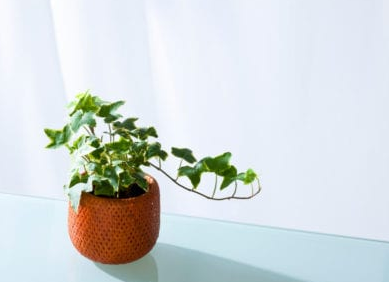
Care!!!
They fit best in the category of low-maintenance indoor plants. For watering, let the top of it dry first. Then water it.
WARNING!!! English Ivy is not safe for pets.
Remove Toxins: formaldehyde, xylene, toluene, benzene,
9. Chinese Evergreen
Scientific Name: Aglaonema
This is one of the most common houseplants. It is the preferred choice for beginners as it is a low-maintenance indoor plant. However, it also cleanses the air by removing the toxins. The beautifully textured leaves add an exquisite element to your indoors.
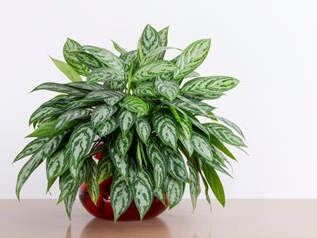
Care!!!
This plant can grow in low light and low water conditions. It thrives in well-drained soil and a humid environment. Therefore, you should water it every 7 to 10 days in summer and once every two weeks in winter. It is recommended that you fertilize your Chinese Evergreen plants twice a year.
Remove Toxins: Formaldehyde, carbon monoxide, trichloroethylene, and xylene.
10. Dragon Tree
Scientific Name: Dracaena marginata
If you are looking for a plant that has lived for many years with little care, then the Dragon tree is the perfect option for you. This plant belongs to the Dracaena family. And like all other dracaena family members, it grows several feet tall. This also is a good air purifier, and it takes low maintenance to handle it.
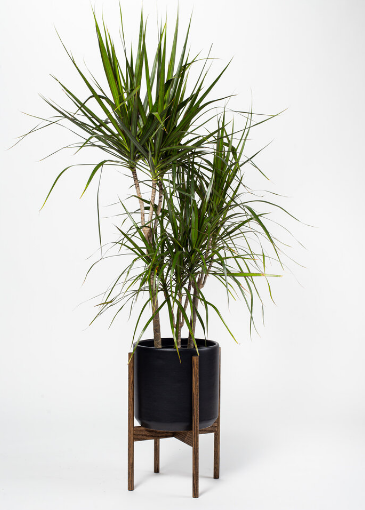
Care!!!
Do not let the water be stagnant on the plant’s roots. These plants don’t like this. They might die. Let the water dry first, and then pour water. Watering once in 8-10 days would work.
Remove Toxins: Formaldehyde, benzene, and carbon dioxide.
11. Gerbera Daisy
Scientific Name: Gerbera Jamesoni
The Gerbera Daisy is a great indoor plant. It also adds beauty to your space with its pink flowers. Moreover, it is another plant that received top marks in NASA’s 1989 Clean Air Study. This excellent air-purifying plant significantly improves the air quality in just 24 hours. It eliminates 50% of the formaldehyde, 67% of the benzene, and 35% of the trichloroethylene from the air.
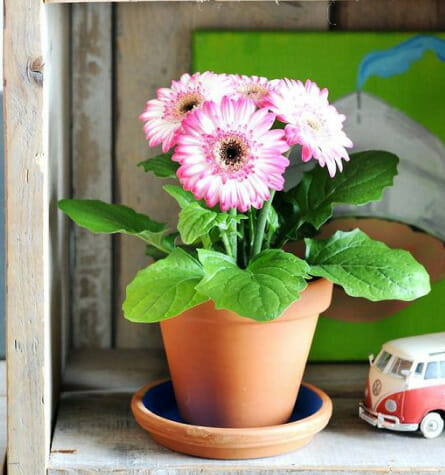
Care!!!
Gerbera daisy is not a complex plant to maintain indoors. But it is a low grower. It can take 18-24 weeks for its flowers to bloom after planting. It will require minimal care if it is kept in bright sunlight. Moreover, thoroughly water the plant but only water when the soil feels dry to the touch.
Remove Toxins: formaldehyde, benzene, trichloroethylene, and carbon monoxide
12. Pygmy Date Palm
Scientific Name: Phoenix roebelenii
The pygmy date palm can quickly grow indoors provided the bright indirect sunlight. Its narrow arching leaflets can grow up to 6-10 ft. It is a hardy and durable plant and makes a remarkable statement in your living room.

Care!!!
Pygmy thrives in relatively hot climates and requires little maintenance. In a lesser light condition, you must be careful not to overwater. They are low-maintenance indoor plants that do not require much attention. You only need medium light and no excessive water to get started.
Remove Toxins: formaldehyde and xylene.
13. ZZ Plant
Scientific Name: Zamioculcas zamiifoliai
ZZ plants are the ideal starter plants. They are easy to handle and require less care. Its small, glossy dark green leaves can clean the air. It can remove toxic and volatile organic compounds hence purifying the air.
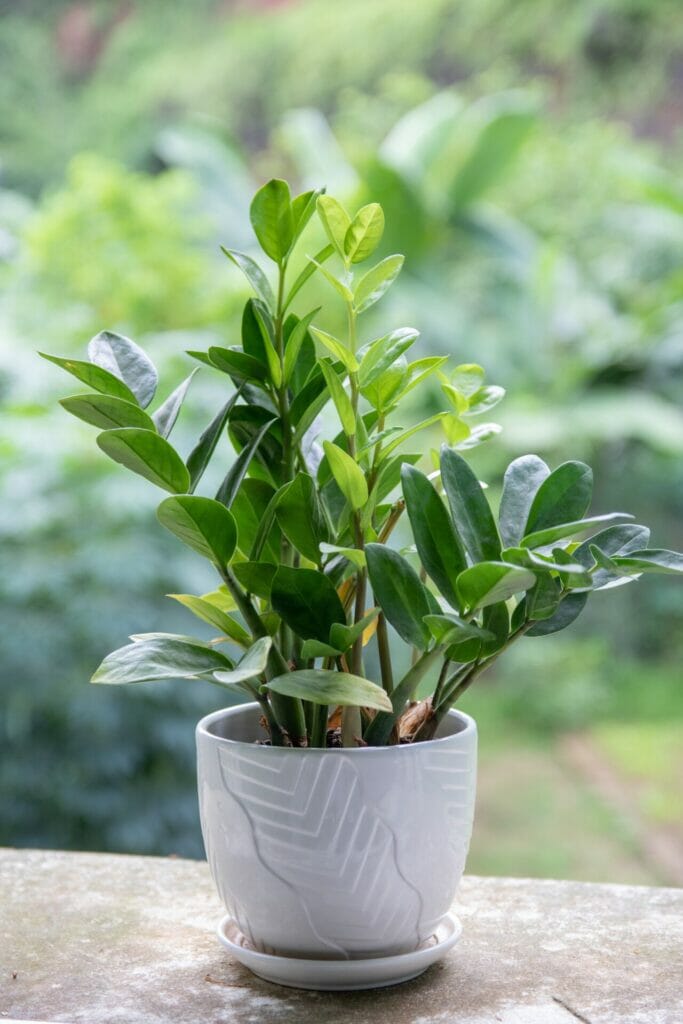
Care!!!
ZZ plants can grow in low lights. It loves well-drained soil, so there is no need to water it frequently. Since it can tolerate low humidity, so it is ideal for offices.
Remove Toxins: benzene, toluene, ethylbenzene and xylene.
WARNING!!! All parts of the ZZ plant are poisonous to pets and humans.
Related Article: 10 Toxic Houseplants That Are Dangerous for Children and Pets
14. Monstera
Scientific Name: Monstera deliciosa
Monstera is a tropical plant, but it is adaptable and easy to care for. Monsteras are in trend among plant lovers because they are low-maintaiance indoor plants that also provide clean air. The Monstera leaves resemble swiss cheese due to their holes. It is a beautiful plant with a distinct graphic appearance.

Care!!!
It is easy to take care of Monstera. Water this beautiful big plant once every two weeks. And it can also survive in low light and humid places. However, in low lights, growth can be slow. However, avoid bright and direct sunlight as it can burn the beautiful leaves of Monstera.
Remove Toxins: formaldehyde and benzene
15. Kimberly fern
Scientific Name: Nephrolepis obliterata
Kimberly fern makes a beautiful indoor plant with its long, feather-like narrow fronds. It is an outdoor plant but can grow perfectly indoors. As it requires little to no care, it is an excellent beginner’s plant. Moreover, Kimberly fern is a natural humidifier, so if you live in an area where the air is dry, you must have this plant in your home to add moisture to your space.
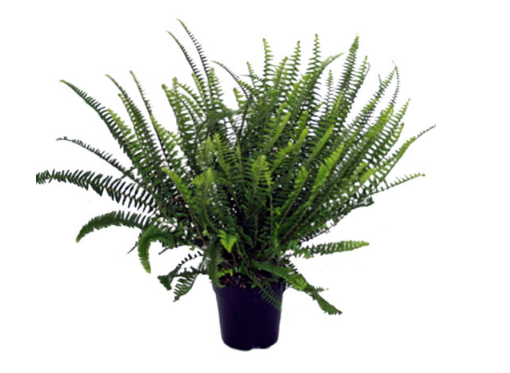
Care!!!
Kimberly fern likes moist soil and indirect sunlight. So avoid keeping it in direct sunlight. Moreover, keep its soil moist by frequent watering. You can also fertilize this plant in the summers.
Remove Toxins: formaldehyde and alcohol
16. Boston fern
Scientific Name: Nephrolepis exaltata
This gorgeous plant looks fantastic in hanging planters and baskets with its sword-shaped leaves falling downwards. It is also an air-filtering plant, absorbing dangerous toxins from the air hence purifying it.

Care!!!
Keep the soil moist and place it in the window sill where it can get filtered light, and your plant is set to go. In summers, cut the fronds back by 2 inches. This will help in regeneration and increase the growth of leaves.
Remove Toxins: formaldehyde and xylene.
17. Dumb Cane Plant
Scientific Name: Dieffenbachia
Dumb cane, also known as leopard lily, has beautiful foliage. They require minimal care and help to clean indoor air. It is a common houseplant due to its easy care. However, most people don’t know that it is toxic to humans and pets and is harmful if ingested. But if you keep it at a height, it is an excellent choice to have indoors because it removes toxins from the air providing clean breathing air for you.
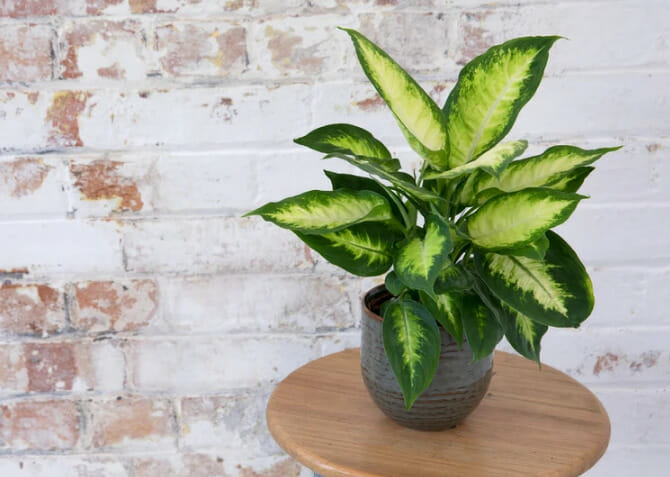
Care!!!
Dumb cane thrives well in indirect light and moist soil. However, the soil must not be soggy because it can cause root rot due to overwatering.
Remove Toxins: Xylene
WARNING!!! Dumb cane is poisonous to humans, cats, and dogs.
18. Philodendron
Scientific Name: Philodendron hederaceum
With its heart-shaped leaves, Philodendron is a pleasing addition to your living rooms. It is available in different sizes and colors. Philodendrons are NASA -approved indoor plants that clean the air. They absorb the formaldehyde, which is generally present in carpets and house cleaning items.
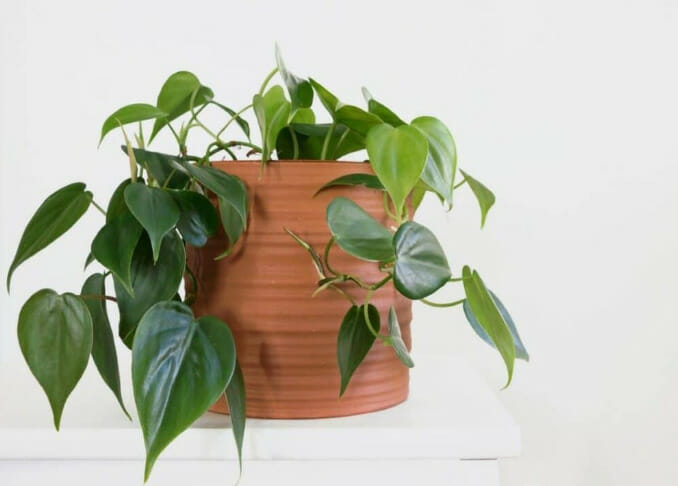
Care!!!
These plants are adaptable and can adjust to any environment. However, they need a medium to bright indirect light for optimal growth.
19. Money tree
Scientific Name: Pachira aquatic
Money trees with big green leaves and braided trunks symbolize fortune and prosperity. It is assumed that the braided trunk will trap the money and bring it to your home. However, this is not the only reason to have this plant at home. The money tree is an air-purifying plant and also reduces anxiety and stress.

Care!!!
Money trees prefer a mix of direct and indirect sunlight. Moreover, it prefers well-draining soil. So, give it a good watering in a week or two, depending upon the condition of the soil.
Remove Toxins: Benzene, formaldehyde, Carbon Monoxide, and xylene
20. Maranta
Scientific Name: Maranta leuconeura
This beautiful tropical plant is a low-maintenance indoor plant. As it spreads low, it looks great in hanging baskets. Maranta or Prayer plants are perfect for the house’s dark corners that don’t receive direct sunlight.
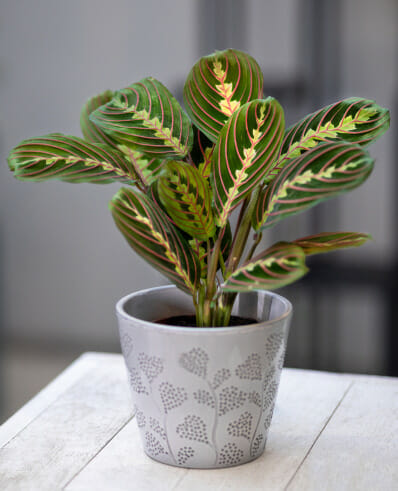
Care!!!
Maranta is not suitable for areas that have bright direct sunlight. Moreover, keep its soil moist and water once a week to meet its water demands.
Remove Toxins: Carbon dioxide
21. Weeping Fig/Ficus
Scientific Name: Ficus Benjamina
This small tree is a trendy indoor plant. It can grow between two and 10 feet tall. Moreover, it comes in different styles. It is one of the best plants for improving air quality.

Care!!!
Like other ficus plants, it prefers bright, indirect sunlight to be watered weekly. Make sure the soil gets dry between waterings.
Remove Toxins: formaldehyde, trichloroethylene, and benzene.
Now that you’ve chosen your plants, it’s time to start looking for fun, decorative pots for your plants to have a home.
Related Article: The Best Decorative Indoor Planter Options For You
Related Article: 10 Best Indoor Terracotta Pots for Your Plants
Conclusion
If you liked this article, please visit our website for more articles on plants and planters.
